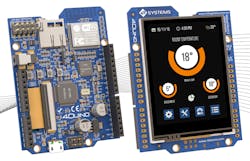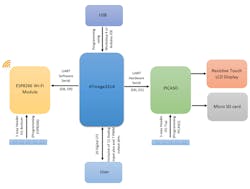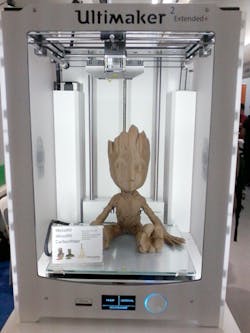At the Philippines’ second IoT Summit, carrying the theme “Powering a smart and connected Philippines,” more than 30 exhibitors convened to display a variety of technologies that contribute to the dynamic development and spreading popularity of the Internet of Things (to check out the show on Facebook, click here). From RFID to augmented-reality applications, one can’t help but be amazed at how IoT’s encompassing influence spurs innovation from all sectors of society. Below are some technologies that stood out at the summit.
4D
What comes to mind when one encounters the term “4D”? Could it refer to the 4th dimension, time? In the jargon of IoT, it has another meaning. The firm 4D Systems, involved in intelligent graphics solutions for a myriad of applications, developed the 4duino, an Arduino-compatible thin-film-transistor (TFT) LCD module (resistive touch) with Wi-Fi.
The 4duino—an Arduino equipped with an LCD interface and Wi-Fi.
As with any conveniently priced commercial programmable controller, the 4duino has sparked the imagination of makers, birthing the 4D Maker movement. Home-automation activities, such as toggling the lights on and off, adjusting the speed of an electric fan, etc., have been demonstrated through miniature house models. Nifty projects like a standalone application similar to “Paint,” 4D holograms (in a glass-enclosed medium), and even a spinning LCD wheel (whose images vary with orientation) were on display. One of the representatives was kind enough to demonstrate how to program a 4duino using its latest easy-to-use developer kit.
Here’s a comprehensive block diagram of the 4duino.
3D
Also on exhibit were 3D printers, which commonly employ fused deposition modeling (FDM), the process of laying down different materials in layers to form a desired aggregate. This technology has been around since the 1980s, proliferating only after its patent expired. An equivalent term, fused filament fabrication (FFF), denotes only one layer, which is a continuous filament of a thermoplastic material.
Perhaps coined for unconstrained use (according to other sources), it’s the pervasive process for hobbyist 3D printing. If one can’t compromise on accuracy, stereolithography (SLA) may be preferred for a loftier price tag. The process involves curing a photopolymer through a UV laser.
Though not included, selective laser sintering (SLS) is worth mentioning due to its strengths against FFF and SLA. It has the accuracy of SLA, but also material flexibility that can counter costs. It’s the method of choice with metals and exotic materials.
FFF 3D printers can further IoT projects by cutting manufacturing time and expenses. Some endeavors may require particular components that need to fit the application of interest. For example, special housing for a 4duino to be mounted some five to six feet above the floor can be manufactured conveniently within a short span of time. Any crucial details or turnarounds are addressed immediately because the design layout is easily managed by the requester through a CAD tool.
This “Groot” figurine was produced by the Ultimaker, a 3D printer that employs FDM.
RFID
No convention on IoT is complete without radio-frequency identification (RFID). After all, the technology has enhanced and revolutionized the way companies do business. Typical applications in the industry include attendance monitoring, logistics, warehousing, and so on.
RFID also took material security to a whole new level through accurate tracking. Asset tracking, baby protection and mother-baby matching, hand hygiene, temperature monitoring, duress attack alarm, bed occupancy alarm, wandering patient alarm, fall detection alert, artwork protection, and prisoner tracking are but a few applications to this ubiquitous tech.
The booths featured handheld readers that operate on ultra-high frequency (UHF) having an omnidirectional read/write range of a few meters, though RFID also uses low frequency (LF) and high frequency (HF). Remember that wavelengths captured by an antenna with the most emphasis are 1/4th its length. So, we need a really big antenna for the lower-frequency bands. The tags come in all shapes and sizes, depending on its use. One demonstrated product was capable of acquiring/locating 31 tags at once.
Smart Sensor Networks
Also on display were a bunch of sensors and sensor nodes used in a smart sensor-network system. Sensors deployed in remote areas communicate with sensor nodes through XBee, LoRa, GPRS, 3G, Wi-Fi, you name it. Then information is sent forward to a gateway to be stored in the cloud.
Smart sensor-network systems help in any task that requires monitoring. For example, in urban applications, such systems aid in monitoring the structural health of infrastructures through vibrations and material condition. Intelligent and weather-adaptive street lighting can be implemented. Local government and residents can be kept up-to-date on city pollution levels in real time.
All of these technologies have changed every aspect of man’s daily life. We personally interact with them, though most may not realize it. At this year’s summit, the exhibitions and conferences certainly created a deeper appreciation for the Internet of Things among many attendees. It’s exciting to ruminate on what innovations IoT could bring in the near future.




